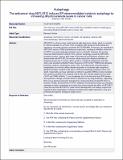Por favor, use este identificador para citar o enlazar a este item:
http://hdl.handle.net/10261/211443COMPARTIR / EXPORTAR:
 SHARE SHARE
 CORE
BASE CORE
BASE
|
|
| Visualizar otros formatos: MARC | Dublin Core | RDF | ORE | MODS | METS | DIDL | DATACITE | |

| Título: | The anti-cancer drug ABTL0812 induces ER stress-mediated cytotoxic autophagy by increasing dihydroceramide levels in cancer cells. |
Autor: | Muñoz-Guardiola, Pau; Casas, Josefina CSIC ORCID ; Megías-Roda, Elisabet; Solé, Sonia; Perez-Montoyo, Héctor; Yeste-Velasco, Marc; Erazo, Tatiana; Dièguez-Martínez, Nora; Espinosa-Gil, Sergio; Muñoz-Pinedo, Cristina; Yoldi, Guillermo; Abad, José Luis CSIC ORCID ; Segura, Miguel F.; Moran, Teresa; Romeo, Margarita; Bosch-Barrera, Joaquim; Oaknin, Ana; Alfón, Jose; Domènech, Carles; Fabriàs, Gemma CSIC ORCID ; Velasco, Guillermo; Lizcano, José M. | Palabras clave: | Autophagy Cancer Dihydroceramide Clinical trials ER stress UPR |
Fecha de publicación: | 13-may-2020 | Editor: | Taylor & Francis | Citación: | Autophagy (2020) | Resumen: | ABTL0812 is a first-in-class small molecule with anti-cancer activity, which is currently in clinical evaluation in a phase 2 trial in patients with advanced endometrial and squamous non-small cell lung carcinoma (NCT03366480). Previously, we showed that ABTL0812 induces TRIB3 pseudokinase expression, resulting in the inhibition of the AKT-MTORC1 axis and macroautophagy/autophagy-mediated cancer cell death. However, the precise molecular determinants involved in the cytotoxic autophagy caused by ABTL0812 remained unclear. Using a wide range of biochemical and lipidomic analyses, we demonstrated that ABTL0812 increases cellular long-chain dihydroceramides by impairing DEGS1 (delta 4-desaturase, sphingolipid 1) activity, which resulted in sustained ER stress and activated unfolded protein response (UPR) via ATF4-DDIT3-TRIB3 that ultimately promotes cytotoxic autophagy in cancer cells. Accordingly, pharmacological manipulation to increase cellular dihydroceramides or incubation with exogenous dihydroceramides resulted in ER stress, UPR and autophagy-mediated cancer cell death. Importantly, we have optimized a method to quantify mRNAs in blood samples from patients enrolled in the ongoing clinical trial, who showed significant increased DDIT3 and TRIB3 mRNAs. This is the first time that UPR markers are reported to change in human blood in response to any drug treatment, supporting their use as pharmacodynamic biomarkers for compounds that activate ER stress in humans. Finally, we found that MTORC1 inhibition and dihydroceramide accumulation synergized to induce autophagy and cytotoxicity, phenocopying the effect of ABTL0812. Given the fact that ABTL0812 is under clinical development, our findings support the hypothesis that manipulation of dihydroceramide levels might represents a new therapeutic strategy to target cancer. | Versión del editor: | https://doi.org/10.1080/15548627.2020.1761651 | URI: | http://hdl.handle.net/10261/211443 | DOI: | 10.1080/15548627.2020.1761651 |
| Aparece en las colecciones: | (IQAC) Artículos |
Ficheros en este ítem:
| Fichero | Descripción | Tamaño | Formato | |
|---|---|---|---|---|
| The anticancer drug ABTL0812 induces ER stress-mediated cytotoxic autophagy by.pdf | 3,09 MB | Adobe PDF |  Visualizar/Abrir |
CORE Recommender
PubMed Central
Citations
44
checked on 20-abr-2024
SCOPUSTM
Citations
61
checked on 19-abr-2024
WEB OF SCIENCETM
Citations
65
checked on 24-feb-2024
Page view(s)
237
checked on 26-abr-2024
Download(s)
540
checked on 26-abr-2024
Google ScholarTM
Check
Altmetric
Altmetric
Artículos relacionados:
NOTA: Los ítems de Digital.CSIC están protegidos por copyright, con todos los derechos reservados, a menos que se indique lo contrario.
